Single nucleotide polymorphisms in premature ovarian failure-associated genes in a Chinese Hui population
- PMID: 25954833
- PMCID: PMC4464472
- DOI: 10.3892/mmr.2015.3762
Single nucleotide polymorphisms in premature ovarian failure-associated genes in a Chinese Hui population
Abstract
Premature ovarian failure (POF) is an ovarian defect characterized by the premature depletion of ovarian follicles in individuals <40 years old, and is a major cause of infertility in females. Genetic factors are considered to be responsible for the development of POF, however, the exact pathogenesis remains to be elucidated in the majority of cases. In the present study, the single nucleotide polymorphisms (SNPs) of growth differentiation factor 9 (GDF9), bone morphogenetic protein 15 (BMP15), inhibin βB (INHBB) and follicle stimulating hormone receptor (FSHR) genes were investigated, and their association with POF in a Chinese Hui population of the Ningxia Hui Autonomous Region in western China was evaluated. Peripheral blood samples were collected from 63 patients diagnosed with POF (POF group) and 58 normal control individuals (control group), from which the genomic DNA was isolated. The GDF9, BMP15, INHBB and FSHR genes were amplified using polymerase chain reaction assays, and their SNPs were determined by sequencing. In the four SNPs identified across the GDF9 loci, D57Y (169G>T), rs1049127 (546G>A), rs254286 (447C>T) and rs254285 (969C>G), the frequencies of the 546G>A genotype and allele A were significantly higher in the POF group, compared with the normal control group (34.92, vs. 6.90%; P<0.05 and 19.05, vs. 3.23%; P<0.05, respectively), while no significant differences were observed in the occurrence of the c.447C>T and c.969C>G mutations between the two groups (60.32, vs. 50% and 50.79, vs. 55.17%, respectively). The c.169G>T mutation within the GDF9 gene was only detected in two patients with POF, and the mutation did not occur in the normal control group. A total of three SNPs were detected within the BMP15 gene, including rs3810682 (-9C>G), rs79377927 (788_789insTCT) and rs17003221 (852C>T), and no significant differences were observed in the frequencies of the -9C>G and 852C>T genotypes between the POF and control groups (7.94, vs. 6.90% and 4.76, vs. 3.45%, respectively). The 788_789insTCT genotype was detected in only two patients with POF. A novel mutation, c.1095C>A, was identified in exon 2 of the INHBB gene, however, no significant difference was found in the occurrence of the mutation between the two groups (30.16, vs. 22.41%; P>0.05). The rs6165 (919G>A) and rs6166 (2039G>A) SNPs were detected in exon 10 of the FSHR gene; however, no significant difference was observed in the genotype frequencies between the two groups (92.06, vs. 91.38% and 96.83, vs. 93.10%, respectively). These results demonstrated that GDF9 c.169G>T (D57Y), c.546G>A (rs1049127), and BMP15 rs79377927 (788_789insTCT) were associated with POF in the Chinese Hui population.
Figures

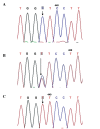
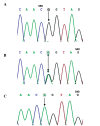
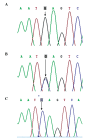

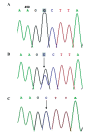


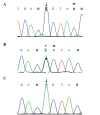
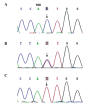
Similar articles
-
"Evaluation of four genes associated with primary ovarian insufficiency in a cohort of Mexican women".J Assist Reprod Genet. 2018 Aug;35(8):1483-1488. doi: 10.1007/s10815-018-1232-3. Epub 2018 Jun 18. J Assist Reprod Genet. 2018. PMID: 29916099 Free PMC article.
-
Association of BMP15 and GDF9 variants to premature ovarian insufficiency.J Assist Reprod Genet. 2019 Oct;36(10):2163-2169. doi: 10.1007/s10815-019-01548-0. Epub 2019 Aug 7. J Assist Reprod Genet. 2019. PMID: 31392662 Free PMC article.
-
Gene variation and premature ovarian failure: a meta-analysis.Eur J Obstet Gynecol Reprod Biol. 2014 Nov;182:226-37. doi: 10.1016/j.ejogrb.2014.09.036. Epub 2014 Oct 6. Eur J Obstet Gynecol Reprod Biol. 2014. PMID: 25445105 Review.
-
Missense mutations in the BMP15 gene are associated with ovarian failure.Hum Genet. 2006 May;119(4):408-15. doi: 10.1007/s00439-006-0150-0. Epub 2006 Mar 1. Hum Genet. 2006. PMID: 16508750
-
The role of BMP15 and GDF9 in the pathogenesis of primary ovarian insufficiency.Hum Fertil (Camb). 2021 Dec;24(5):325-332. doi: 10.1080/14647273.2019.1672107. Epub 2019 Oct 14. Hum Fertil (Camb). 2021. PMID: 31607184 Review.
Cited by
-
"Evaluation of four genes associated with primary ovarian insufficiency in a cohort of Mexican women".J Assist Reprod Genet. 2018 Aug;35(8):1483-1488. doi: 10.1007/s10815-018-1232-3. Epub 2018 Jun 18. J Assist Reprod Genet. 2018. PMID: 29916099 Free PMC article.
-
Association of an APBA3 Missense Variant with Risk of Premature Ovarian Failure in the Korean Female Population.J Pers Med. 2020 Oct 26;10(4):193. doi: 10.3390/jpm10040193. J Pers Med. 2020. PMID: 33114509 Free PMC article.
-
GDF9His209GlnfsTer6/S428T and GDF9Q321X/S428T bi-allelic variants caused female subfertility with defective follicle enlargement.Cell Commun Signal. 2024 Apr 20;22(1):235. doi: 10.1186/s12964-024-01616-8. Cell Commun Signal. 2024. PMID: 38643161 Free PMC article.
-
Precision reproductive medicine: multigene panel testing for infertility risk assessment.J Assist Reprod Genet. 2017 Aug;34(8):967-973. doi: 10.1007/s10815-017-0938-y. Epub 2017 May 3. J Assist Reprod Genet. 2017. PMID: 28470451 Free PMC article. Review.
-
Selected Genetic Factors Associated with Primary Ovarian Insufficiency.Int J Mol Sci. 2023 Feb 23;24(5):4423. doi: 10.3390/ijms24054423. Int J Mol Sci. 2023. PMID: 36901862 Free PMC article. Review.
References
Publication types
MeSH terms
Substances
LinkOut - more resources
Full Text Sources
Other Literature Sources
Medical

